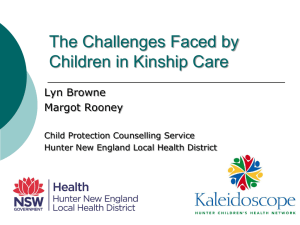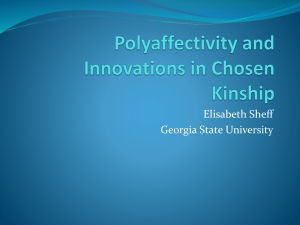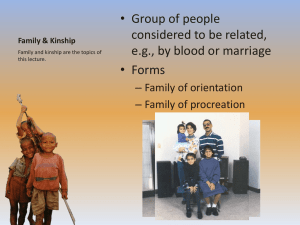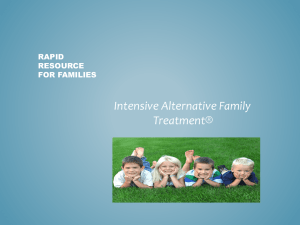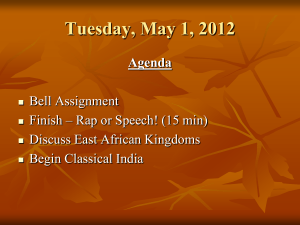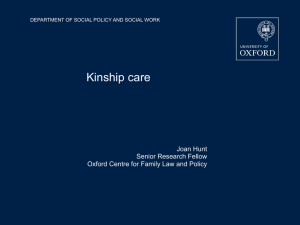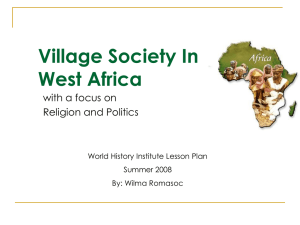Alliance Project:
advertisement
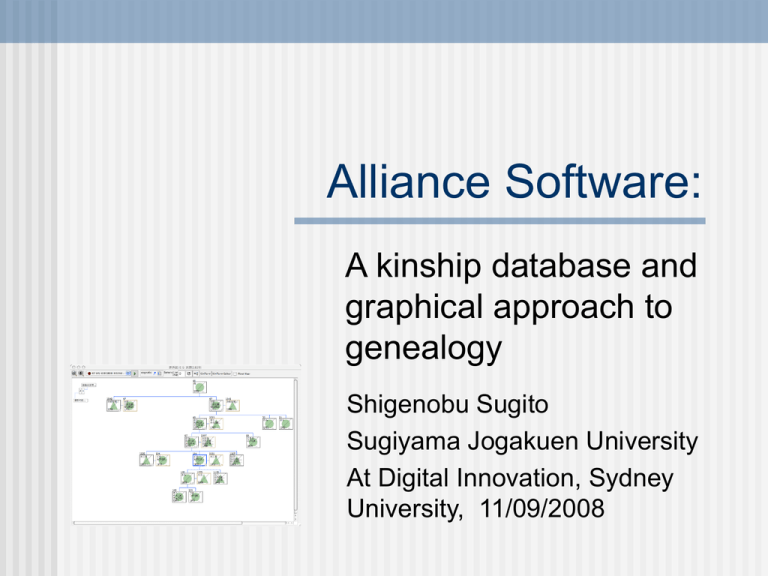
Alliance Software: A kinship database and graphical approach to genealogy Shigenobu Sugito Sugiyama Jogakuen University At Digital Innovation, Sydney University, 11/09/2008 Preface or background story My fieldtrip this year (01/08/08 - 13/09/08) Sydney, and Campbelltown • Sydney: Usyd and UTS • Campbelltown: Town development, social housing, and local Indigenous families Alice Springs, Yuendom, and Papunya • Wrlpiri Media, Youth Education, and Art Centre • After the Intervention Auckland, and Christchurch • Maori researchers, and Maori organization • Whakapapa: identity, and benefits Why genealogy and kinship database? Contents My background: Alliance project: genealogy and kinship database Fieldwork Computer and cultural & social sciences framework Interface solutions Graphical solutions New Alliance Visualisation Demonstration Alliance Alliance Site (URL: http://study.hs.sugiyama-u.ac.jp/alliance/) • Alliance Blog • Alliance User registration • Alliance Download Site Standalone Alliance Why genealogy and kinship? We are living in multi-layers of human relations. We are born in a family of orientation. • Can’t refuse any relations from sociological parents and their relatives! • Can’t choose our neighbours or locals! We are growing up and establish our own relationship include partners. We, maybe, have own family of procreation. We belongs to primary groups and secondary groups. We, somehow, need identification of our self, especially in modern network society. Image your kinship! Ego focal family to extended family and From kinship terminology (1) In English From kinship terminology (2) Or Yolngu Kinship study in the modern network society Reproductive technology and kinship: M. Strathern • 1992 ”Reproducing the Future” • 1999 ”Technologies of Procreation: kinship in the age of assisted conception” Strong concern about the genealogy databases in immigrant society like US and Australia: Varieties of databases: onboard name list of immigrant ship, ancestoral country, surname, families, Royal families, and so on Mormon’s genealogy concept produced GEDCOM system: tracing up to “Adam”, not “Eva” Genealogy resources in the Web Indigenous knowledge movement Mythical knowledge, ceremonial knowledge, and kinship knowledge are related with Land rights, heritage, and native title in Australia and another counties Australia: National Native Title Tribunal: http://www.nntt.gov.au/Pages/default.aspx New Zealand: Waitangi Tribunal: http://www.waitangi-tribunal.govt.nz/ Resources in the web Genealogy as SNS (Social Network System) Dec. 2006: Amiglia: http://www.amiglia.com/ (no more?) Jan. 2007: Geni: http://www.geni.com Nov. 2007: TechCrunch: Geni Clone Growing A Lot Faster Than Geni • Verwandt.de Other resources Ancestry.Com Cyndi’s list: genealogy database Genographic Project by National Geography and IBM Revised kinship study: framework Aboriginal Australia was seen as an important place for the study of kinship in past decades, however a rejection of African descent theory and new thinking about social organization in Aboriginal societies have led to the neglect of kinship in recent years. Of course, other trends in modern anthropology are contributory factors. Among others, the American anthropologist David Graeber has written about kinship in industrial societies in his 2005 essay, Fragments of an Anarchist Anthropology. Graeber says, ‘The term “kinbased” is often used the way people used to use the word “primitive”; these are exotic societies which are in no way like our own. (That’s why it is assumed we need anthropology to study them; entirely different disciplines, like sociology and economics, are assumed to be required to study modern ones.) But then the exact same people who make this argument will usually take it for granted that the main social problems in our own, “modern” society (or “postmodern”: for present purposes it’s exactly the same thing) resolve around race, class, and gender. In other words, precisely from the nature of our kinship system.’ (Graeber 2004: 51-52). Most would readily agree with Graeber’s proposition that industrial societies are just as ‘kin-based’ as any others. However, in teaching anthropology, the study of kinship appears to be useful only as a means of understanding ‘classic’ ethnography. This is a deplorable situation in anthropology, in my view. Perhaps it is time to pay a lot more attention to and become better equipped to understand kinship in modern / post-modern societies. See http://www.prickly-paradigm.com/paradigm14.pdf. Also http://en.wikipedia.org/wiki/Fragments_of_an_Anarchist_Anthropology . Why commercial software? Even professional anthropologists have used to use commercial software, like “Family Tree Maker” for Windows, “Reunion” for Macintosh, and so on, for a long time. Those application suit to the any anthropological field? Of course, those are not! The purpose of those software is to trace to the ancestor as a unilineal way, not to seek the afinal relationship and describing the kinship relationship, anyhow. However, many anthropologist are still using. Why? Fit to the court case? • Yes, many lawyers in Native Title Tribunal and the court don’t have any world-wide knowledge of kinship. They are a sort of so-call ethno-centric people, but they are legally correct. Problem is the usage of commercial software by the anthropologists affects people’s unique kinship knowledge Fieldwork in Micronesia and Australia Micronesian Study Material culture: housing and clothes in 1979 and 1981 Aboriginal study Fieldwork in Arnhem Land, NT, since 1984 • NME, National Museum of Ethnology, Osaka, Japan, Australian collection project and research • As the result, our research group has organised two Aboriginal Art Exhibition in 1986 in Kobe, and 1992 in NME Main topics • Aboriginal Arts & Crafts: Oenpelli • Housing issues in Aboriginal remote communities: Manigrida • Kinship and population: Galiwin’ku Related organisation: ANU, and AIATSIS Computing, cultural & social sciences Simulation analysis of prehistoric Japanese population in Jomon era (BP2000-12000) in 1984 Cluster analysis of distribution of slash burn farming in rural Japan in Edo era (BP150) in 1985 Macroscopic population dynamics study Findings of two patterns: urban and rural type of farming Development of “Alliance” application, kinship database and genealogy by Java since 1996 Family analysis of Edo period from demographic document records in 2005 Alliance project: genealogy and kinship database Alliance Project concepts in brief Alliance is an anthropological fieldwork tool Alliance is a universal tool for common kinship system Focused on genealogy database and kinship study Flexible format With converter project Alliance operation will be shown later Alliance is applied as a common platform: Windows, Macintosh, Unix, or Linux Free software, but need registration before download To be a open source software in near future Joint project with historical demography with another database Japanese historical records: linkage historical document database Korean’s historical records England parish records? Blue Mad Bay genealogy in Eastern Arnhem Land Graphical database in Central Desert Linkage project with Prof. Nakata’s project Prof. Oshima’s fieldnote and genealogy in TSI in 1970’ Another linkage project in near future New Project Extended and/or new project Tiwi population study and Melbourne population study Database project: • To examine XML-based database compatibility Contribution to indigenous society research? • Kinship database, genealogy, and demography Graphical solution User interface Fieldworker (anthropologists) - conservative triangle and circle as a signs: another possibility? Database and as a analysis tool kit • Analytic path to Pajek, or other network analysis Why 3D? More interactive Tangled relations in consanguinial and afinal relationship Multiple layers (windows) Geo-spacial linkage with Alliance James Rose case GoogleEarth API Interface solutions Interface format CSV GEDCOM XML External solution Historical demography converter possible • P-graph • API linkage: GoogleEarth • GIS softwares New Alliance On the go WebAlliance Time-basedAlliance Planning NetworkAlliance GeospaceAlliance Visualisation of genealogy (1) Visualisation of genealogy (2) QuickTime™ and a decompressor are needed to see this picture. Left: James Rose, personal communication Right: Prof. Douglas White (UC Irvine): http://eclectic.ss.uci.edu/~drwhite/pgraph/p-graphs.html Basic concept of WebAlliance PC Basic logic of the Alliance Java VM (Java Runtime environment) Database We are using HSQLDB, now, however, we change any other xml-based database. Alliance Engine database HTTP Communication module Browser (Internet Explorer, FireFox etc. Communication module to HTTP browser. We are using Tomcat, now. Key image is small web server is working in your PC. James Rose case His presentation in ”Tradition, Adaptation, The ‘Tide of History’ Workshop” at UQ on 23/07/2008 sample Abstructs: titled as “Structural event indexing and social network analysis” P-graph analysis: D. White James Rose Moving Pattern Analysis Kinship Network Geni.Com Verwandt.de Thoroughbred Ancestry.Com: sample family tree Ancestry.Com: top page GenographicProject: National Geography and IBM CyndisList Wikipedia: GEDCOM
